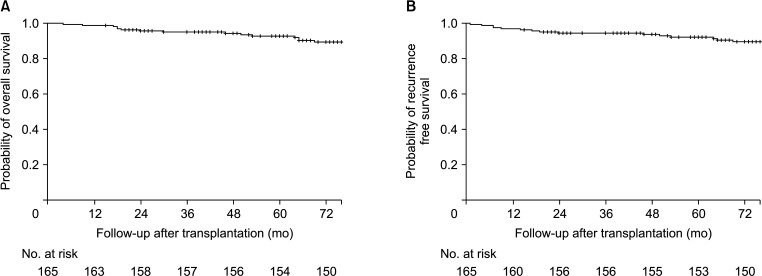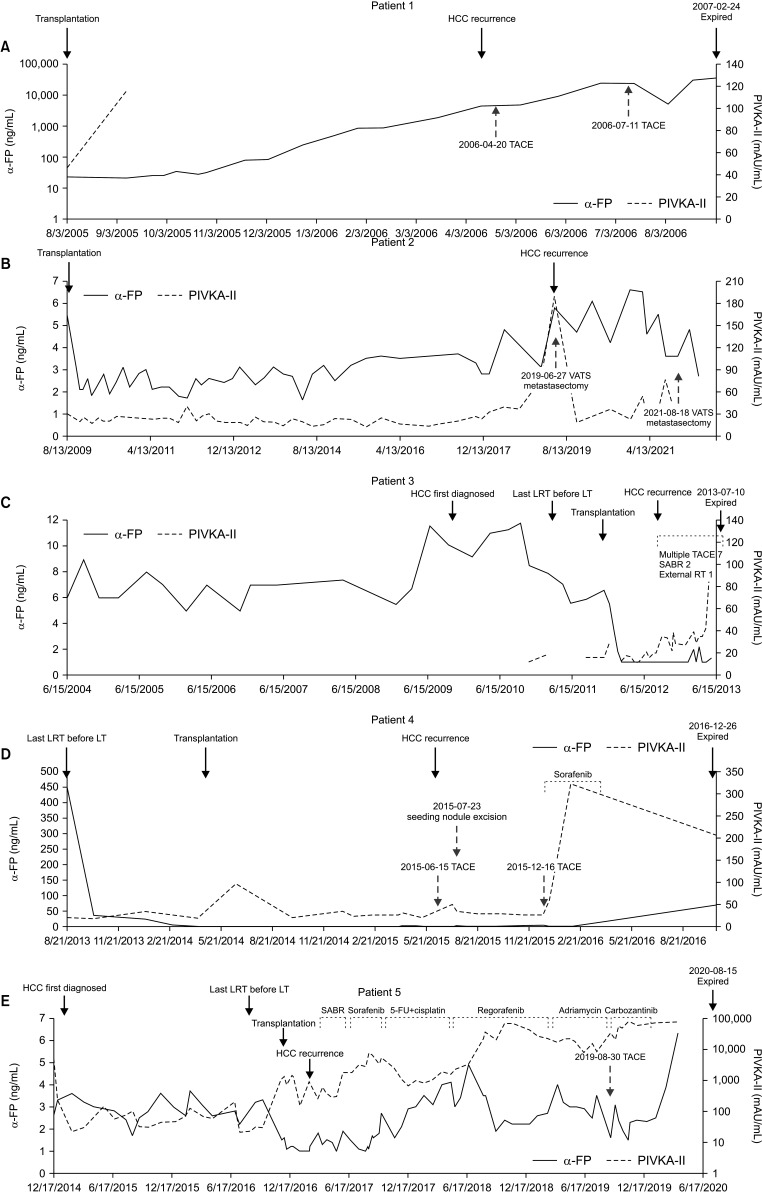Ann Surg Treat Res.
2023 Jul;105(1):47-56. 10.4174/astr.2023.105.1.47.
Recurrence in patients with totally necrotic nodules of hepatocellular carcinoma after liver transplantation: “totally” an inaccurate description
- Affiliations
-
- 1Department of Surgery, Seoul National University College of Medicine, Seoul, Korea
- KMID: 2544612
- DOI: http://doi.org/10.4174/astr.2023.105.1.47
Abstract
- Purpose
Total necrosis of hepatocellular carcinoma (HCC) achieved via locoregional treatment (LRT) is considered to indicate a lack of tumor viability. Nonetheless, there is insufficient evidence of recurrence after liver transplantation (LT) in patients with such a status. The aim of this study was to investigate the prognosis of patients diagnosed with totally necrotic nodules upon explant hepatectomy after LT.
Methods
We conducted a retrospective study of patients diagnosed with totally necrotic nodules after LT for HCC. A total of 165 patients with HCC who underwent living- or deceased-donor LT from 2000 to 2020 in our hospital were included.
Results
A total of 5 patients (3.0%) exhibited HCC recurrence during a median follow-up of 84 months (range, 4–243 months) after LT. The 5-year overall and recurrence-free survival rates of these patients were 92.8% and 92.2%, respectively. Four patients in the HCC-recurrence group (80.0%) died even after further treatment, including transarterial chemoembolization, surgery, and systemic treatment. Both univariate and multivariate analyses of clinicopathological factors identified a maximum diameter of the totally necrotic nodules of >5 cm as the only factor associated with tumor recurrence following LT (P = 0.005 and P = 0.009, respectively).
Conclusion
Total necrosis of HCC via LRT yielded excellent survival outcomes for patients undergoing LT. Nevertheless, patients with large tumors should be considered at high risk of recurrence after LT, suggesting the need for their active surveillance during the follow-up period.
Figure
Reference
-
1. McGlynn KA, Petrick JL, El-Serag HB. Epidemiology of hepatocellular carcinoma. Hepatology. 2021; 73 Suppl 1(Suppl 1):4–13.2. Kulik L, El-Serag HB. Epidemiology and management of hepatocellular carcinoma. Gastroenterology. 2019; 156:477–491. PMID: 30367835.3. Huang DQ, El-Serag HB, Loomba R. Global epidemiology of NAFLD-related HCC: trends, predictions, risk factors and prevention. Nat Rev Gastroenterol Hepatol. 2021; 18:223–238. PMID: 33349658.4. Reig M, Forner A, Rimola J, Ferrer-Fàbrega J, Burrel M, Garcia-Criado Á, et al. BCLC strategy for prognosis prediction and treatment recommendation: the 2022 update. J Hepatol. 2022; 76:681–693. PMID: 34801630.5. Llovet JM, Schwartz M, Mazzaferro V. Resection and liver transplantation for hepatocellular carcinoma. Semin Liver Dis. 2005; 25:181–200. PMID: 15918147.6. Mazzaferro V, Regalia E, Doci R, Andreola S, Pulvirenti A, Bozzetti F, et al. Liver transplantation for the treatment of small hepatocellular carcinomas in patients with cirrhosis. N Engl J Med. 1996; 334:693–699. PMID: 8594428.7. DiNorcia J, Florman SS, Haydel B, Tabrizian P, Ruiz RM, Klintmalm GB, et al. Pathologic response to pretransplant locoregional therapy is predictive of patient outcome after liver transplantation for hepatocellular carcinoma: analysis from the US Multicenter HCC Transplant Consortium. Ann Surg. 2020; 271:616–624. PMID: 30870180.8. Lee JH, Cho Y, Kim HY, Cho EJ, Lee DH, Yu SJ, et al. Serum tumor markers provide refined prognostication in selecting liver transplantation candidate for hepatocellular carcinoma patients beyond the Milan criteria. Ann Surg. 2016; 263:842–850. PMID: 26779979.9. Agopian VG, Harlander-Locke MP, Ruiz RM, Klintmalm GB, Senguttuvan S, Florman SS, et al. Impact of pretransplant bridging locoregional therapy for patients with hepatocellular carcinoma within Milan criteria undergoing liver transplantation: analysis of 3601 patients from the US Multicenter HCC Transplant Consortium. Ann Surg. 2017; 266:525–535. PMID: 28654545.10. Yao FY, Kerlan RK Jr, Hirose R, Davern TJ 3rd, Bass NM, Feng S, et al. Excellent outcome following down-staging of hepatocellular carcinoma prior to liver transplantation: an intention-to-treat analysis. Hepatology. 2008; 48:819–827. PMID: 18688876.11. Huo TI, Huang YH, Wu JC, Lee PC, Chang FY, Lee SD. Induction of complete tumor necrosis may reduce intrahepatic metastasis and prolong survival in patients with hepatocellular carcinoma undergoing locoregional therapy: a prospective study. Ann Oncol. 2004; 15:775–780. PMID: 15111346.12. Shim JH, Kim KM, Lee YJ, Ko GY, Yoon HK, Sung KB, et al. Complete necrosis after transarterial chemoembolization could predict prolonged survival in patients with recurrent intrahepatic hepatocellular carcinoma after curative resection. Ann Surg Oncol. 2010; 17:869–877. PMID: 20033326.13. Chen Z, Lin X, Chen C, Chen Y, Zhao Q, Wu L, et al. Analysis of preoperative circulating tumor cells for recurrence in patients with hepatocellular carcinoma after liver transplantation. Ann Transl Med. 2020; 8:1067. PMID: 33145286.14. Wang PX, Xu Y, Sun YF, Cheng JW, Zhou KQ, Wu SY, et al. Detection of circulating tumour cells enables early recurrence prediction in hepatocellular carcinoma patients undergoing liver transplantation. Liver Int. 2021; 41:562–573. PMID: 33205544.15. Xu X, Lu D, Ling Q, Wei X, Wu J, Zhou L, et al. Liver transplantation for hepatocellular carcinoma beyond the Milan criteria. Gut. 2016; 65:1035–1041. PMID: 25804634.16. Yao FY, Mehta N, Flemming J, Dodge J, Hameed B, Fix O, et al. Downstaging of hepatocellular cancer before liver transplant: long-term outcome compared to tumors within Milan criteria. Hepatology. 2015; 61:1968–1977. PMID: 25689978.17. Halazun KJ, Najjar M, Abdelmessih RM, Samstein B, Griesemer AD, Guarrera JV, et al. Recurrence after liver transplantation for hepatocellular carcinoma: a new MORAL to the story. Ann Surg. 2017; 265:557–564. PMID: 27611615.18. Mazzaferro V, Sposito C, Zhou J, Pinna AD, De Carlis L, Fan J, et al. Metroticket 2.0 model for analysis of competing risks of death after liver transplantation for hepatocellular carcinoma. Gastroenterology. 2018; 154:128–139. PMID: 28989060.19. European Association for the Study of the Liver. EASL Clinical Practice Guidelines: management of hepatocellular carcinoma. J Hepatol. 2018; 69:182–236. PMID: 29628281.20. Marrero JA, Kulik LM, Sirlin CB, Zhu AX, Finn RS, Abecassis MM, et al. Diagnosis, staging, and management of hepatocellular carcinoma: 2018 practice guidance by the American Association for the Study of Liver Diseases. Hepatology. 2018; 68:723–750. PMID: 29624699.21. Tabrizian P, Holzner ML, Mehta N, Halazun K, Agopian VG, Yao F, et al. Ten-year outcomes of liver transplant and downstaging for hepatocellular carcinoma. JAMA Surg. 2022; 157:779–788. PMID: 35857294.22. Hong SK, Lee KW, Lee S, Hong SY, Suh S, Han ES, et al. Impact of tumor size on hepatectomy outcomes in hepatocellular carcinoma: a nationwide propensity score matching analysis. Ann Surg Treat Res. 2022; 102:193–204. PMID: 35475226.23. Amado V, González-Rubio S, Zamora J, Alejandre R, Espejo-Cruz ML, Linares C, et al. Clearance of circulating tumor cells in patients with hepatocellular carcinoma undergoing surgical resection or liver transplantation. Cancers (Basel). 2021; 13:2476. PMID: 34069569.24. Rhu J, Kim JM, Choi GS, Kwon CHD, Joh JW. Continuing five or more locoregional therapies before living donor salvage liver transplantation for hepatocellular carcinoma is related to poor recurrence-free survival. Ann Surg Treat Res. 2018; 95:152–160. PMID: 30182022.25. Lee EC, Kim SH, Shim JR, Park SJ. Small-for-size grafts increase recurrence of hepatocellular carcinoma in liver transplantation beyond Milan criteria. Liver Transpl. 2018; 24:35–43. PMID: 28885774.26. Matter MS, Decaens T, Andersen JB, Thorgeirsson SS. Targeting the mTOR pathway in hepatocellular carcinoma: current state and future trends. J Hepatol. 2014; 60:855–865. PMID: 24308993.27. Geissler EK, Schnitzbauer AA, Zülke C, Lamby PE, Proneth A, Duvoux C, et al. Sirolimus use in liver transplant recipients with hepatocellular carcinoma: a randomized, multicenter, open-label phase 3 trial. Transplantation. 2016; 100:116–125. PMID: 26555945.28. Hong SK, Lee KW, Yoon KC, Kim HS, Ahn SW, Kim H, et al. Different prognostic factors and strategies for early and late recurrence after adult living donor liver transplantation for hepatocellular carcinoma. Clin Transplant. 2019; 33:e13703. PMID: 31464006.29. Poon RT, Fan ST, O'Suilleabhain CB, Wong J. Aggressive management of patients with extrahepatic and intrahepatic recurrences of hepatocellular carcinoma by combined resection and locoregional therapy. J Am Coll Surg. 2002; 195:311–318. PMID: 12229937.30. Hong SK, Lee KW, Kim HS, Yoon KC, Yi NJ, Suh KS. Living donor liver transplantation for hepatocellular carcinoma in Seoul National University. Hepatobiliary Surg Nutr. 2016; 5:453–460. PMID: 28123999.
- Full Text Links
- Actions
-
Cited
- CITED
-
- Close
- Share
- Similar articles
-
- Outcome of total necrosis of hepatocellular carcinoma after liver transplantation: is it really totally gone?
- Liver Transplantation for Hepatocellular Carcinoma
- Can hepatocellular carcinoma recurrence be prevented after liver transplantation?
- Surgical Management of Hepatocellular Carcinoma
- Risk factors for poor survival after recurrence of hepatocellular carcinoma after liver transplantation



